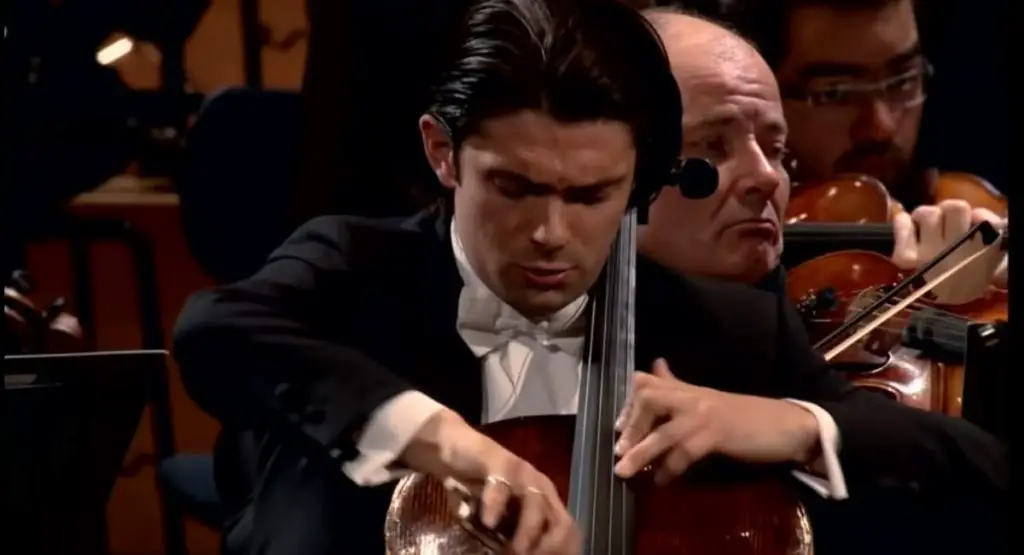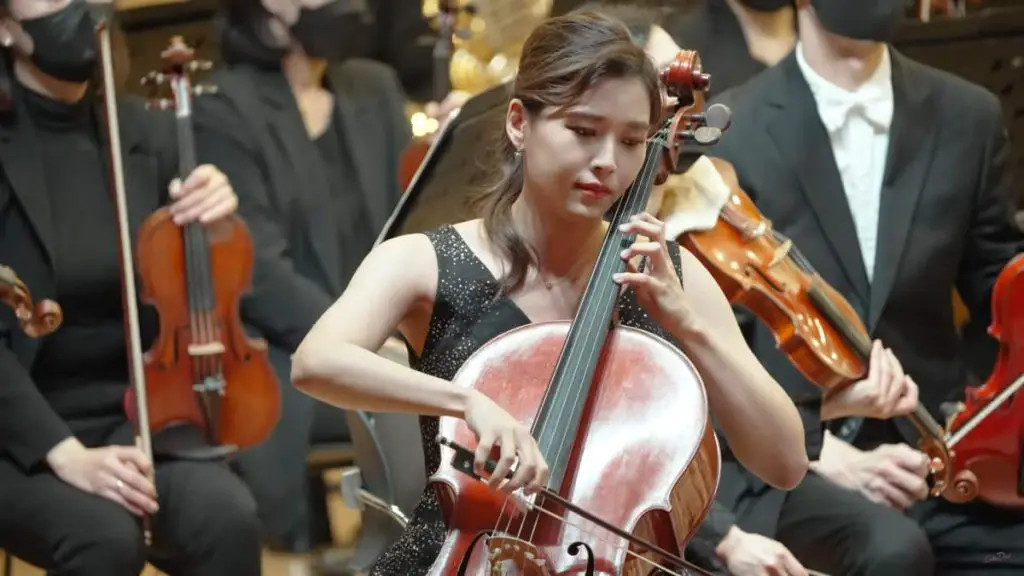Accompanied by the Hankyung Arte Philharmonic Orchestra, the Franco-Belgian cellist Camille Thomas performs Antonín Dvořák’s Cello Concerto in B minor, Op. 104, B. 191. Conductor: Joong Bae Jee. This performance was recorded at the Seoul Art Center in September 2023.
Antonín Dvořák’s Cello Concerto
Antonín Dvořák’s Cello Concerto in B minor, Op. 104, is one of the most revered works in the cello repertoire and a cornerstone of late Romantic music. Composed between 1894 and 1895 during Dvořák’s time in the United States, it reflects both his homesickness for Bohemia and his fascination with American culture. The concerto was written for Dvořák’s close friend, the renowned cellist Hanuš Wihan, although the composer resisted many of Wihan’s suggestions for virtuosic flourishes, preferring to maintain the work’s lyrical and symphonic integrity. The piece was premiered in London on March 19, 1896, by the English cellist Leo Stern.
Dvořák’s Cello Concerto is notable for its rich orchestration and the prominent role of the orchestra, which interacts with the soloist in a dialogue rather than simply providing accompaniment. This approach creates a work that is deeply symphonic in scope, with the cello often singing above or within the texture rather than dominating it. Dvořák was a master of melody, and this concerto is filled with beautiful, memorable themes that express a wide range of emotions, from deep melancholy to joyful exuberance.
The concerto also reflects Dvořák’s ability to blend different musical influences. While it is grounded in the Romantic tradition, the work also incorporates elements of Czech folk music, which was a significant influence on Dvořák throughout his career. This folk-influence is evident in the rhythmic vitality and dance-like character of many passages, as well as in the work’s overall emotional depth and sincerity.
Dvořák was initially hesitant to write a cello concerto, as he felt the instrument’s tone was too limited to sustain a full concerto. However, after hearing Victor Herbert’s Second Cello Concerto in New York, he was inspired to revisit the idea, and his own concerto soon followed. The result is a piece that showcases the cello’s lyrical and expressive capabilities while also demanding considerable technical skill from the soloist.
One of the most poignant aspects of the concerto is its personal significance for Dvořák. During the composition of the work, he learned of the illness of his sister-in-law, Josefina Kaunitzová, with whom he had been deeply in love before marrying her sister. The second theme of the first movement, which is later recapitulated in the final movement, is based on one of Josefina’s favorite songs, “Kéž duch můj sám,” which Dvořák had composed earlier. This theme gives the concerto an additional layer of emotional resonance, making it not only a musical masterpiece but also a deeply personal statement by the composer.
Movements
1. Allegro
The first movement of Antonín Dvořák’s Cello Concerto in B minor, Op. 104, is a masterful blend of symphonic grandeur and lyrical expressiveness. Marked Allegro, it opens with a powerful orchestral introduction, setting the stage with a dramatic and assertive theme presented by the clarinets, which is then taken up and expanded by the full orchestra. This theme is robust and confident, establishing the movement’s serious and expansive character.
The solo cello enters after the orchestral exposition, introducing a contrasting theme that is more lyrical and introspective. Dvořák writes with a deep understanding of the cello’s capabilities, allowing the instrument to sing with warmth and expression. The cello’s first entrance is particularly striking, as it begins quietly, almost as if emerging from the orchestral texture, and then gradually asserts itself with a more passionate and singing tone.
Throughout the movement, Dvořák maintains a careful balance between the soloist and the orchestra, ensuring that the cello is always prominent but never overpowering. The dialogue between the cello and the orchestra is intricate and dynamic, with the cello often responding to or elaborating on themes introduced by the orchestra. This interplay creates a rich tapestry of sound that is both complex and deeply engaging.
The development section of the movement is particularly noteworthy for its dramatic tension and emotional depth. Dvořák explores the thematic material introduced earlier, transforming and developing it in ways that highlight both the cello’s virtuosity and its expressive range. The music moves through a series of contrasting moods, from stormy and intense passages to moments of serene beauty.
As the movement progresses, the return of the main themes in the recapitulation is both familiar and fresh, as Dvořák reinterprets the material in light of the development section. The movement concludes with a powerful coda, in which the cello and orchestra come together in a final, climactic statement of the main theme, bringing the movement to a dramatic and satisfying close.
2. Adagio, ma non troppo
The second movement of Antonín Dvořák’s Cello Concerto in B minor, Op. 104, is marked Adagio ma non troppo, and it provides a lyrical and deeply reflective contrast to the dramatic first movement. This movement is the emotional heart of the concerto, showcasing Dvořák’s gift for melody and his ability to create music that is both intimate and expansive.
The movement begins with a serene, song-like theme introduced by the woodwinds, creating a calm and introspective atmosphere. This melody, tender and expressive, sets the stage for the solo cello, which enters with a gentle and lyrical response. The cello’s role in this movement is to sing, almost like a human voice, conveying a sense of deep emotion and nostalgia.
One of the most poignant aspects of this movement is the incorporation of a theme that holds personal significance for Dvořák. The second theme, which the solo cello introduces, is based on the song “Kéž duch můj sám” (“Leave Me Alone”), a piece that Dvořák had composed earlier and was a favorite of his sister-in-law, Josefina Kaunitzová. This theme adds an extra layer of emotional depth to the movement, as it reflects Dvořák’s love and sorrow for Josefina, who was seriously ill at the time he was composing the concerto. The theme is tender and melancholic, and its appearance in the movement imbues the music with a sense of longing and remembrance.
Throughout the movement, Dvořák’s orchestration is particularly sensitive, ensuring that the solo cello is never overshadowed by the orchestra. The interplay between the cello and the orchestra is delicate and finely balanced, with the cello often weaving in and out of the orchestral texture in a way that enhances the lyrical quality of the music. The orchestra provides a lush and supportive backdrop, with the strings and woodwinds creating a warm, enveloping sound.
The movement also includes passages of great intensity, where the cello expresses deeper and more turbulent emotions. These moments of heightened drama serve to contrast with the more serene and lyrical sections, creating a rich emotional landscape that keeps the listener engaged throughout. Dvořák’s use of dynamics and phrasing in the cello part is masterful, allowing the soloist to explore a wide range of expressive possibilities.
The movement concludes quietly, with the cello and orchestra gradually fading away, leaving a lingering sense of melancholy and introspection. This gentle ending perfectly encapsulates the movement’s overall character-a deeply felt meditation on love, loss, and memory, rendered with Dvořák’s characteristic warmth and humanity. The Adagio ma non troppo stands as one of the most beautiful and moving slow movements in the concerto repertoire, a testament to Dvořák’s ability to convey profound emotion through music.
3. Adagio, ma non troppo
The third movement of Antonín Dvořák’s Cello Concerto in B minor, Op. 104, marked Allegro moderato, serves as the powerful and triumphant conclusion to the concerto. This movement is a synthesis of the lyrical beauty and dramatic intensity that characterize the entire work, bringing the concerto to a rousing and emotionally charged finale.
The movement begins with an energetic and robust theme, introduced by the orchestra. This theme is rhythmically driven and exudes a sense of confidence and determination. The solo cello enters with a response that is equally assertive, taking up the theme and developing it with virtuosic flair. Dvořák’s writing for the cello in this movement is particularly demanding, requiring the soloist to navigate through rapid passages, double stops, and wide leaps, all while maintaining the lyrical quality of the music.
One of the most striking features of this movement is its structure, which blends elements of a rondo and a sonata form. The main theme recurs throughout the movement, interspersed with contrasting episodes that explore different moods and textures. These episodes often allow the solo cello to shine in a more introspective and lyrical light, providing a contrast to the more vigorous and rhythmic main theme. The alternation between these contrasting sections keeps the listener engaged and highlights Dvořák’s ability to seamlessly weave together different musical ideas.
As the movement progresses, the music becomes increasingly intense, with the soloist and orchestra engaging in a dynamic and sometimes playful dialogue. The interplay between the cello and the various sections of the orchestra is complex and richly textured, showcasing Dvořák’s skill as an orchestrator. The cello often leads the way, with the orchestra responding and building on the material presented by the soloist.
In the final section of the movement, Dvořák brings back the poignant theme from the second movement, based on the song “Kéž duch můj sám.” This return of the theme adds an unexpected emotional depth to the finale, creating a moment of reflection amidst the otherwise vigorous and triumphant music. It’s a deeply personal touch that ties the entire concerto together, reminding the listener of the underlying emotional narrative of the work.
The concerto concludes with a powerful coda, where the main theme returns in full force, now transformed into a final, triumphant statement. The solo cello and orchestra join together in a dramatic and jubilant conclusion, bringing the concerto to a close with a sense of resolution and fulfillment. The final moments are marked by a surge of energy and exuberance, leaving the listener with a lasting impression of the work’s emotional and musical richness.
Dvořák’s Cello Concerto in B minor ends not just with a display of technical brilliance but with a profound sense of emotional completeness. The third movement encapsulates the journey of the entire concerto, blending drama, lyricism, and personal reflection into a powerful and unforgettable finale.
Sources
- Cello Concerto (Dvořák) on Wikipedia
- Cello Concerto, Op. 104 (Dvořák, Antonín) on the International Music Score Library Project website
- Antonín Dvořák’s Cello Concerto in B Minor, Op. 104 on the Encyclopedia Britannica website


![Dvořák: Cello Concerto [Ella van Poucke]](https://cdn-0.andantemoderato.com/wp-content/uploads/2023/03/Dvorak-Cello-Concerto-Ella-van-Poucke-1024x576.jpg)
